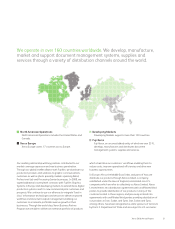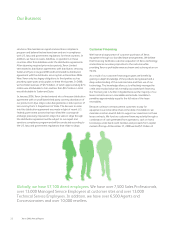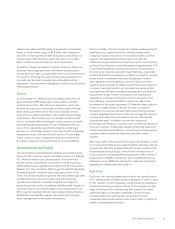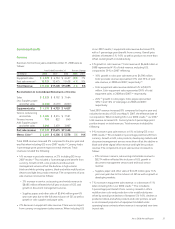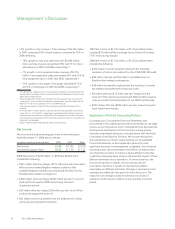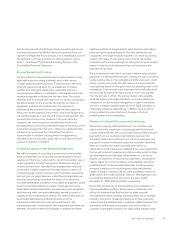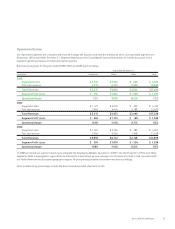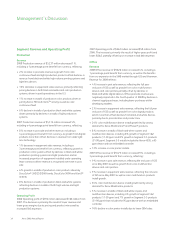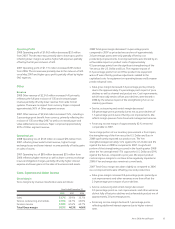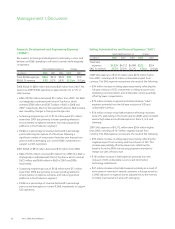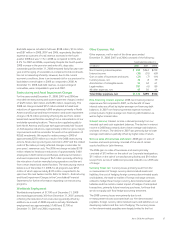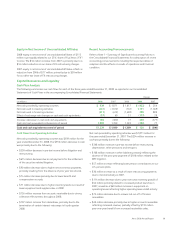Xerox 2008 Annual Report Download - page 32
Download and view the complete annual report
Please find page 32 of the 2008 Xerox annual report below. You can navigate through the pages in the report by either clicking on the pages listed below, or by using the keyword search tool below to find specific information within the annual report.
Management’s Discussion
the life of the portfolio. We consider all available information in our
quarterly assessments of the adequacy of the provision for
doubtful accounts.
The current economic environment has increased the risk of
non-collection of receivables. We have accordingly considered this
increased risk in the evaluation and assessment of our allowance
for doubtful accounts at year-end. Collection risk is somewhat
mitigated by the fact that our receivables are fairly well dispersed
among a diverse customer base both in size and geography. Days
sales outstanding remained fairly flat year-over-year. In addition,
the aging of receivables has not increased significantly. Accounts
receivable balances greater than 60 days outstanding were 17%
of total gross accounts receivables at December 31, 2008 as
compared to 15% at December 31, 2007. However, we continue to
assess our receivable portfolio in light of the current economic
environment and its impact on our estimation of the adequacy of
the allowance for doubtful accounts.
As discussed above, in preparing our Consolidated Financial
Statements for the three year period ended December 31, 2008,
we estimated our provision for doubtful accounts based on
historical experience and customer-specific collection issues. This
methodology has been consistently applied for all periods
presented. During the five year period ended December 31, 2008,
our reserve for doubtful accounts ranged from 3.0% to 4.2% of
gross receivables. Holding all other assumptions constant, a
1-percentage point increase or decrease in the reserve from the
December 31, 2008 rate of 3.4% would change the 2008 provision
by approximately $98 million.
Pension and Post-Retirement Benefit Plan Assumptions
We sponsor defined benefit pension plans in various forms in
several countries covering substantially all employees who meet
eligibility requirements. Post-retirement benefit plans cover
primarily U.S. employees for retirement medical costs. Several
statistical and other factors that attempt to anticipate future
events are used in calculating the expense, liability and asset
values related to our pension and post-retirement benefit plans.
These factors include assumptions we make about the discount
rate, expected return on plan assets, rate of increase in healthcare
costs, the rate of future compensation increases and mortality.
Difference between these assumptions and actual experiences are
reported as net actuarial gains and losses and are subject to
amortization to net periodic pension cost over the average
remaining service lives of the employees participating in the
pension plan.
Cumulative actuarial losses for our pension plans as of
December 31, 2008 were $1.8 billion, as compared to $1 billion at
December 31, 2007. The change from December 31, 2007 relates
primarily to actual losses on plan assets in 2008 as compared to
expected returns partially offset by an increase in the discount
rate. The total actuarial loss will be amortized in the future, subject
to offsetting gains or losses that will change the future
amortization amount.
We have utilized a weighted average expected rate of return on
plan assets of 7.6% for 2008, 7.6% for 2007 and 7.8% for 2006,
on a worldwide basis. In estimating this rate, we considered the
historical returns earned by the plan assets, the rates of return
expected in the future and our investment strategy and asset mix
with respect to the plans’ funds.
During 2008, the actual loss on plan assets was $1.5 billion,
primarily as a result of the significant declines in the equity
markets during the fourth quarter of 2008. In estimating the 2009
expected rate of return we considered this significant decline in the
fair value of our plan assets as well as potential changes in our
investment mix, partly in response to the significant volatility
expected in the equity markets for the foreseeable future. The
weighted average expected rate of return on plan assets we will
utilize for 2009 will be 7.4% as compared to 7.6% in 2008.
For purposes of determining the expected return on plan assets, we
utilize a calculated value approach in determining the value of the
pension plan assets, as opposed to a fair market value approach.
The primary difference between the two methods relates to a
systematic recognition of changes in fair value over time (generally
two years) versus immediate recognition of changes in fair value.
Our expected rate of return on plan assets is then applied to the
calculated asset value to determine the amount of the expected
return on plan assets to be used in the determination of the net
periodic pension cost. The calculated value approach reduces the
volatility in net periodic pension cost that can result from using the
fair market value approach. The difference between the actual
return on plan assets and the expected return on plan assets is
added to, or subtracted from, any cumulative differences that
arose in prior years. This amount is a component of the net
actuarial gain or loss.
Another significant assumption affecting our pension and post-
retirement benefit obligations and the net periodic pension and
other post-retirement benefit cost is the rate that we use to
discount our future anticipated benefit obligations. The discount
rate reflects the current rate at which the pension liabilities could
be effectively settled considering the timing of expected payments
for plan participants. In estimating this rate, we consider rates of
return on high quality fixed-income investments included in various
published bond indices, adjusted to eliminate the effects of call
provisions and differences in the timing and amounts of cash
outflows related to the bonds. In the U.S. and the U.K., which
comprise approximately 80% of our projected benefit obligations,
30 Xerox 2008 Annual Report



